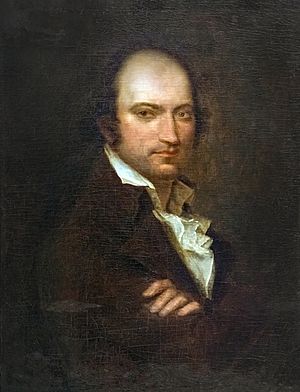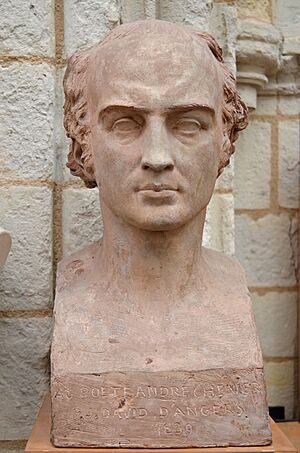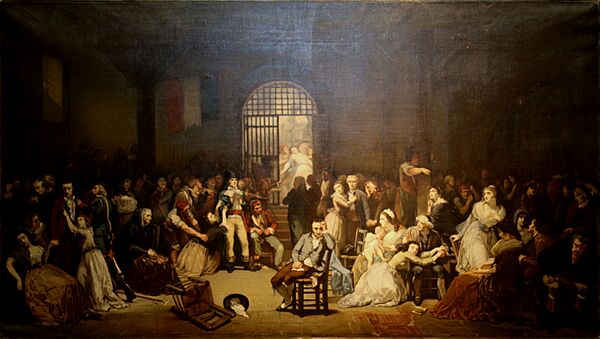André Chénier facts for kids
Quick facts for kids
André Chénier
|
|
|---|---|

Portrait during his last captivity by Suvée
|
|
| Born | 30 October 1762 Constantinople, Ottoman Empire |
| Died | 25 July 1794 (aged 31) Paris, France |
| Occupation | Writer |
| Nationality | French |
| Genre | Poetry |
André Marie Chénier (French pronunciation: [ɑ̃dʁe maʁi ʃenje]; October 30, 1762 – July 25, 1794) was a French poet. He had Greek and French family roots.
Chénier lived during the exciting and dangerous time of the French Revolution. This was a period of big changes in France. Sadly, he was sentenced to death during this time.
His emotional poems are very important. They show him as one of the first poets of the Romantic movement. His career ended suddenly when he was executed for supposedly going against the government.
Chénier's life has inspired many artworks. One famous example is the opera Andrea Chénier by Umberto Giordano.
Contents
The Life of André Chénier

André Chénier was born in Constantinople (modern-day Istanbul, Turkey). His father, Louis Chénier, was a French diplomat. His mother, Élisabeth Santi-Lomaca, was of Greek origin.
When André was three, his family moved back to France. He spent some of his childhood with an aunt in Carcassonne. A town square there is named after him today.
He was a very bright student. He was especially good at translating old Greek and Roman texts into French poetry. He studied at the Collège de Navarre in Paris.
In 1783, Chénier joined the army for a short time. But he soon realized he wanted to be a poet. He returned to Paris and spent time with his family and their friends. His mother's home was a meeting place for many artists and thinkers.
Becoming a Poet
Chénier decided to become a poet. He wrote in the neoclassical style, which was popular then. This style was inspired by ancient Greek and Roman art. It focused on order, reason, and clear forms.
A trip to Rome, Naples, and Pompeii in 1784 greatly inspired him. For almost three years, he focused on writing poetry. He wrote many poems about nature and simple country life. These were called idylls and bucolics. He was inspired by ancient Greek poets like Theocritus.
His poems mixed old myths with new feelings. Some of his famous poems from this time include L'Oaristys and La Jeune Tarentine. He also tried writing longer, philosophical poems. One of these was Hermès, which aimed to explain man's place in the universe.
Chénier believed that poetry should combine new ideas with old styles. He famously wrote: "From new thoughts, let us make antique verses."
Time in England
In 1787, Chénier became a secretary for the French ambassador to Britain. He lived in London for a few years. However, he was not happy there. He often made fun of the English people and their customs.
He didn't study English literature much. But some of his poems show small influences from famous English writers. These included William Shakespeare and John Milton.
The French Revolution
The French Revolution began in 1789. This was a huge event in France. People wanted to change the government and society. Chénier's younger brother, Marie-Joseph, became a well-known writer during this time.
Chénier returned to Paris in 1790. He believed the Revolution should lead to a constitutional monarchy. This meant a king who shared power with a government chosen by the people. He thought France needed law and order.
He started writing political articles and poems. He wrote for a newspaper called the Journal de Paris. He also wrote strong poems criticizing those who were too extreme.
In 1792, the political situation became very dangerous. Chénier's moderate views were no longer popular. He had to hide to avoid being arrested. His brother, Marie-Joseph, joined the new government.
Chénier even helped prepare arguments to defend King Louis XVI. The king was later executed.
Imprisonment and Death
After the king's death, Chénier lived quietly outside Paris. But in March 1794, he was arrested by mistake. He was visiting a friend's house when agents came looking for someone else.
He was taken to prison, first to the Luxembourg Palace, then to Prison Saint-Lazare. He spent 140 days in prison. During this time, he continued to write poems. He wrote about the unfairness of the government. These poems were secretly sent out of prison.
In prison, he wrote his most famous poem, "Jeune captive" (The Young Captive). This poem was inspired by a young woman he met in prison. She was also a prisoner.
Just ten days before he died, a painter named Joseph-Benoît Suvée painted his portrait. This is the famous image you see in the infobox.
Chénier was put on trial by the Revolutionary Tribunal. He was found guilty. On July 25, 1794, he was taken to the guillotine in Paris and executed. He was 31 years old.
Just two days later, the leader of the extreme government, Robespierre, was also arrested and executed. Chénier was buried in the Cimetière de Picpus.
André Chénier's Works
Most of Chénier's poems were not published when he was alive. Only two short pieces were printed. His fame grew after his death. His poems were slowly found and published.
His famous poem "Jeune Captive" appeared in a magazine in 1795. Another, "La Jeune Tarentine," was published in 1801. Over time, more of his writings were collected.
People have different ideas about Chénier's poetry. Some say he was a pioneer of the Romantic movement. Romanticism focused on feelings, nature, and individual experiences. They saw him as a link to poets like Victor Hugo.
Others argue that his work was more like the last example of 18th-century classicism. This style was more about order and reason.
However, many agree that Chénier was a unique and important poet. The writer Albert Camus called him "the only poet of the times."
Chénier's work was also very popular in Russia. The famous Russian poet Alexandr Pushkin wrote a poem about Chénier's last hours.
Chénier's life and death have inspired many other artists. There are plays, paintings, and poems about him. The most famous is the opera Andrea Chénier by Umberto Giordano. There is also a statue of him in the Luxembourg Gardens in Paris.
See Also
 In Spanish: André Chénier para niños
In Spanish: André Chénier para niños
- 1793 Chénier Act on "right of the author" (French alternative concept to copyright)
Legacy
- The rue André Chénier in Aix-en-Provence is named for him.
Images for kids



